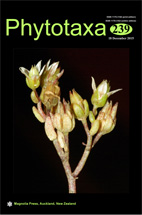Abstract
Prosthechea Knowles & Westcott (1838: 111) is the third largest genus of Laeliinae Bentham (1881: 287) with 117 species (Chase et al. 2015). The group of species corresponding to Prosthechea is widespread in the Neotropics, especially in Mexico, Central America and Brazil, and has been treated since the 60’s as distinct from Epidendrum Linnaeus (1763: 1347) but with contradictory generic placement. For example, Dressler & Pollard (1971, 1976) included most species in Encyclia subgenus Osmophytum (Lindley 1841: 81) Dressler & Pollard (1971: 433), but dealt only with Mexican species. Pabst & Dungs (1975, 1977) followed Dressler and treated the Brazilian species also in Encyclia Hooker (1828: t. 2831). Brieger (1960) considered them part of Hormidium (Lindley 1841: 81) Heynhold (1841: 880) and later Pabst et al. (1981) transferred most Brazilian species to Anacheilium Hoffmannsegg (1842: 229). Molecular phylogenetic analyses of plastid and nuclear data confirmed that the whole group was monophyletic (van den Berg et al. 2000, 2009, Higgins et al., 2003). After an extensive discussion on the generic names by Higgins (1997), he established that the oldest name for the whole clade was Prosthechea and proposed most of the new combinations for species previously included in Epidendrum, Encyclia, Anacheilium and Hormidium. Later on, other authors decided to subdivide the group into several segregate genera, and proposed two systems that are themselves conflicting in generic circumscription (Withner & Harding 2004, Chiron & Castro Neto 2003a).

